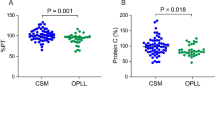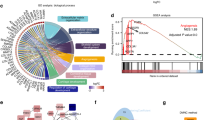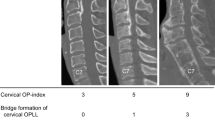Abstract
Study design:
Immnunohistochemical staining of the thickened posterior longitudinal ligament of the cervical spine.
Objectives:
To clarify the histological characteristics of hypertrophy of the posterior longitudinal ligament (HPLL) of the cervical spine and the relationship between HPLL and ossification of the posterior longitudinal ligament (OPLL).
Setting:
Aichi Medical University, Aichi, Japan.
Methods:
Eight specimens of HPLL and two of OPLL were obtained during anterior decompressive surgery on the cervical spine from patients with myelopathy. Hematoxylin and eosin staining, alcian blue staining and immunohistochemical staining with antibodies against bone morphogenetic protein (BMP), transforming growth factor (TGF)-β, proliferating cell nuclear antigen (PCNA), alkaline phosphatase (ALP) and osteopontin (OPN) were carried out on the specimens.
Results:
HPLL showed hyalinoid degeneration, the proliferation of chondrocytes and fibroblast-like spindle cells, infiltration of vessels and small ossification. In four cases, chondroid tissue was prominent with chondrocytes, which were expressed by ALP and OPN. The cells in HPLL were weakly or moderately stained by BMP, TGF-β and PCNA. Their expression was similar to that of OPLL. Immunohistochemical staining was negative for all cells in the control cases.
Conclusions:
Histological and biochemical evidence supports the hypothesis that HPLL transforms into OPLL. The positive expression of BMP and TGF-β in HPLL cells of myelopathic patients, and their similarity to OPLL, suggest that these cells have the potential to differentiate into osteogenic cells. Of note, neither BMP nor TGF-β was demonstrated in the PLL of control subjects. Furthermore, the expression of chondrocytes by ALP and OPN in cartilage-prominent HPLL suggests that the cartilage can be replaced by new bone.
Similar content being viewed by others
Log in or create a free account to read this content
Gain free access to this article, as well as selected content from this journal and more on nature.com
or
References
Mizuno J, Nakgawa H, Hashizume Y . Analysis of hypertrophy of the posterior longitudinal ligament of the cervical spine, on the basis of clinical and experimental studies. Neurosurgery 2001; 49: 1091–1098.
Motegi H et al. Proliferating cell nuclear antigen in hypertrophied spinal ligaments. Spine 1998; 23: 305–310.
Urist MR, DeLange RJ, Finerman GA . Bone cell differentiation and growth factors. Science 1983; 220: 680–686.
Wang EA et al. Recombinant human bone morphogenetic protein induces bone formation. Proc Natl Acad Sci USA 1990; 87: 2220–2224.
Carrington JL . Accumulation, localization, and compartmentation of transformation growth factor-β during endochondral bone development. J Cell Biol 1988; 107: 1969–1975.
Joyce ME, Roberts AB, Sporn MB, Bolander ME . Transforming growth factor-β and initiation of chondrogenesis and osteogenesis in the rat femur. J Cell Biol 1990; 110: 2195–2207.
Noda M, Camilliere JJ . In vivo stimulation of bone formation by transforming growth factor-β. Endocrinology 1989; 124: 2991–2994.
Kawaguchi H et al. Immunohistochemical demonstration of bone morphogenic protein-2 and transforming growth factor-β in the ossification of the posterior longitudinal ligament of the cervical spine. Spine 1992; 17: S33–S36.
Hall PA et al. Proliferating cell nuclear antigen (PCNA) immunolocalization in paraffin sections: an index of cell proliferation with evidence of deregulated expression in some neoplasms. J Pathol 1990; 162: 285–294.
Waseem NH, Lane DP . Monoclonal antibody analysis of the proliferating cell nuclear antigen (PCNA). Structural conservation and the detection of a nucleolar form. J cell Sci 1990; 96: 121–129.
Kato Y et al. Terminal differentiation and calcification in rabbit chondrocyte cultures grown in centrifuge tubes: regulation by transforming growth factor beta and serum factors. Proc Natl Acad Sci USA 1988; 85: 9552–9556.
Franzen A, Oldberg A, Solursh M . Possible recruitment of osteoblastic precusor cells from hypertrophic chondrocytes during initial osteogenesis in cartilaginous limbs of young rats. Matrix 1989; 9: 261–265.
McKee MD et al. Developmental appearance and ultrastructural immunolocalization of a major 66 kDa phosphoprotein in embryonic and post-natal chicken bone. Anat Rec 1990; 228: 77–92.
Kamikozuru M, Yamaura I . Hypertrophy of the cervical posterior longitudinal ligament (a provisional name) causing myelopathy: a case report. Presented at the second annual meeting of the Japan Spine Research Society Tokyo, Japan, November 9, 1974 (in Japanese).
Kurata A et al. Myelopathy caused by hypertrophy of the posterior longitudinal ligament (HPLL): Case report. Noushinkeigeka 1987; 15: 651–655 (Abstract in English).
Toguchi A et al. Myelopathy due to hypertrophy of the posterior longitudinal ligament in cervical spine: an operative case. Kanto J Orthopaed Traumatol 1992; 23: 172–177 (in Japanese).
Hoshi K et al. Fibroblasts of spinal ligaments pathologically differentiate into chondrocytes induced by recombinant human bone morphogenetic protein-2: morphological examinations for ossification of spinal ligaments. Bone 1997; 21: 155–162.
Yonemori K et al. Bone morphogenetic protein receptors and activin receptors are highly expressed in ossified ligaments tissues of patients with ossification of the posterior longitudinal ligament. Am J Pathol 1997; 150: 1335–1347.
Lee K et al. Parathyroid hormone induces sequential c-fos expression in bone cells in vivo: in situ localization of its receptor and c-fos messenger ribonucleic acids. Endocrinology 1994; 134: 441–450.
Yamazaki A, Homma T, Ishikawa S, Okumura H . Magnetic resonance imaging and histologic study of hypertrophic cervical posterior longitudinal ligament. A case report. Spine 1991; 16: 1262–1266.
Acknowledgements
We thank K Kotani and T Mizuno for their technical assistance.
Author information
Authors and Affiliations
Rights and permissions
About this article
Cite this article
Song, J., Mizuno, J., Hashizume, Y. et al. Immunohistochemistry of symptomatic hypertrophy of the posterior longitudinal ligament with special reference to ligamentous ossification. Spinal Cord 44, 576–581 (2006). https://doi.org/10.1038/sj.sc.3101881
Published:
Issue date:
DOI: https://doi.org/10.1038/sj.sc.3101881
Keywords
This article is cited by
-
Expression of proinflammatory cytokines and proinsulin by bone marrow-derived cells for fracture healing in long-term diabetic mice
BMC Musculoskeletal Disorders (2023)
-
Cyclic tensile strain facilitates ossification of the cervical posterior longitudinal ligament via increased Indian hedgehog signaling
Scientific Reports (2020)
-
Ossification of the posterior longitudinal ligament in the cervical spine: a review
International Orthopaedics (2019)
-
Ossification process involving the human thoracic ligamentum flavum: role of transcription factors
Arthritis Research & Therapy (2011)
-
High glucose promotes collagen synthesis by cultured cells from rat cervical posterior longitudinal ligament via transforming growth factor-β1
European Spine Journal (2008)



